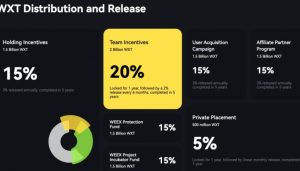Post Views: 42
In this article, we are going to be looking at the most profitable cryptocurrencies to mine right now, what the future looks like for them as well as the best miners to mine them with.
What Is Crypto Mining?
Cryptocurrency mining is the process that powers many Proof-of-Work (PoW) cryptocurrencies, like Bitcoin. It serves two key functions:
- Securing the network: Imagine a giant public ledger recording all cryptocurrency transactions. This ledger, called a blockchain, relies on miners to verify and validate these transactions. Miners essentially act as auditors, ensuring the legitimacy and preventing fraud.
- Introducing new coins: As a reward for their work in securing the network, miners are given newly minted cryptocurrencies. This is how new coins enter circulation for certain cryptocurrencies.
Here’s a simplified breakdown of the mining process:
- Transactions are grouped into blocks: Imagine bundles of receipts waiting to be processed.
- Miners compete to solve a complex mathematical puzzle: This puzzle is like a unique key that unlocks the block.
- The first miner to solve the puzzle “mines” the block: They successfully verify the transactions within and are rewarded with new cryptocurrency.
- The validated block is added to the blockchain: This strengthens the overall security and transparency of the network.
It’s important to note that mining can be quite complex and energy-intensive, requiring specialized hardware and software. Additionally, the profitability of mining can vary depending on several factors, such as the specific cryptocurrency, electricity costs, and mining hardware efficiency.
Crypto Mining Requirements
Crypto mining has several essential requirements, although they can vary depending on the chosen cryptocurrency and your approach:
Hardware
- Mining rig: This is the core of your mining operation. Traditionally, miners used GPUs (graphics processing units), commonly found in high-end gaming computers. However, most profitable mining now utilizes specialized hardware called ASICs (application-specific integrated circuits) designed specifically for mining. ASICs offer significantly higher hash rates (computing power for mining) but come at a much higher cost and are often currency-specific.
- Other hardware: You’ll also need a reliable computer system to run the mining software, a power supply with sufficient wattage to handle the power-hungry hardware, and a cooling system to manage the significant heat generated during mining.
Software
- Mining software: This software interacts with the chosen cryptocurrency’s blockchain and facilitates the communication between your mining rig and the network. Different software exists for different cryptocurrencies.
Additional Considerations
- Stable and affordable electricity: Crypto mining consumes significant electricity. Ensure you have a reliable and preferably cost-effective power source to maintain profitability.
- Technical knowledge: Setting up and maintaining a mining rig requires some technical knowledge, especially when dealing with ASICs.
- Mining pool (optional): Joining a mining pool combines the computing power of multiple miners, increasing your chances of successfully mining a block and sharing the rewards.
Remember, thoroughly research the specific requirements for the cryptocurrency you plan to mine, considering hardware costs, electricity consumption, and current profitability before diving in.
Can I “Mine” Proof-Of-Stake Coins?
While the term “mining” is often used broadly in the cryptocurrency space, it’s technically not accurate for Proof-of-Stake (PoS) coins. PoS blockchains don’t involve the traditional computational power required in Proof-of-Work (PoW) mining.
Instead of “mining,” PoS blockchains use a process called staking. Here’s the key difference:
- PoW mining: Requires solving complex puzzles with specialized hardware to validate transactions and earn rewards.
- PoS staking: This involves locking up your existing coins in a wallet or designated platform to participate in validating transactions and potentially earn rewards.
So, you cannot “mine” PoS coins in the traditional sense. However, you can participate in the network through staking and potentially earn rewards based on the number of coins you stake and the specific protocol of the PoS blockchain.
The Best Cryptocurrencies To Mine Right Now
Kaspa (KAS)
Kaspa (KAS) mining has garnered significant attention recently, with its production of new coins reaching $2 million per day.
Profitability in Kaspa mining depends heavily on the specific model chosen. For example, the ICERIVER KAS KS3M, priced around $8,599.00, reportedly generates $70 per day in mining rewards. However, it’s essential to remember that these figures are estimates and can fluctuate significantly based on market conditions and electricity costs.
Additionally, with the recent introduction of ASIC miners like the ICERIVER KAS KS0 Pro, facilitates a supposedly “plug-and-play” mining experience with reported earnings exceeding energy consumption costs. While this may seem appealing, thorough research and due diligence are still necessary.
Dogecoin (DOGE)
Dogecoin has recently slipped from its position as the second most profitable coin to mine, but it remains the third most profitable option in the current market.
Dogecoin uses the Scrypt mining algorithm, which allows miners to simultaneously earn both Dogecoin and Litecoin through a process called merged mining. Previously, while mining Litecoin, miners would also receive Dogecoin as a byproduct. However, Dogecoin’s market performance has shifted this dynamic.
Dogecoin’s recent growth has made it a more attractive prospect for miners compared to Litecoin. While the Bitmain Antminer L7 remains a popular choice for mining both currencies due to its established performance, it’s important to note that this information is subject to change and newer, more efficient miners may emerge.
Litecoin (LTC)
Litecoin (LTC) is a well-established altcoin that has been around since 2011. It is often considered a “silver” to Bitcoin’s “gold” due to its faster block times and higher maximum supply. While Litecoin’s mining difficulty is lower than Bitcoin’s, it has also become increasingly difficult to mine profitably with traditional CPU or GPU setups. This is because a large portion of Litecoin’s mining hash rate is now controlled by large-scale ASIC mining operations.
However, Litecoin still remains an attractive option for miners due to its several advantages. First, Litecoin’s Scrypt algorithm is designed to be ASIC-resistant, meaning it was originally intended to be mineable with everyday hardware. While ASICs have overcome this to some extent, Litecoin mining remains more accessible to individual miners compared to Bitcoin mining.
Additionally, the lower mining difficulty compared to Bitcoin allows miners to potentially see faster returns on their investment, even with less powerful mining rigs. Finally, Litecoin’s established reputation and presence in the crypto market make it a relatively stable investment with less price volatility compared to newer altcoins.
Chia (XCH)
Chia (XCH) introduces a unique approach to cryptocurrency mining, utilizing hard drives instead of the more prominent ASIC miners. This allows for the potential for building your own mining rig with readily available hardware.
Compression techniques have emerged as a way to optimize hard drive mining performance in Chia. Additionally, plug-and-play options like the Evergreen Miner offer convenient entry points for new users.
While hard drive mining may seem accessible, it’s crucial to consider several factors. Hard drives themselves can be expensive, and pre-built Chia miners often carry a premium. Additionally, the upcoming Chia halving will significantly reduce the daily production of new coins, impacting potential profitability.
Ethereum Classic (ETC)
Ethereum Classic (ETC) can be an attractive option for miners due to several factors. First is its lower mining difficulty compared to major players like Bitcoin making it easier for individual miners using graphics cards to compete and potentially earn rewards.
Additionally, as a more established coin with a longer history and larger community, ETC offers a degree of stability and trust in comparison to newer ventures.
If you are thinking about mining Ethereum Classic (ETC) but want a miner that excels in both performance and low noise level, the Jasminer X16-Q, aptly named for its quiet operation, might be the perfect fit. This niche miner offers excellent efficiency and boasts cutting-edge chip technology, but be prepared for a slightly higher price tag.
Final Thoughts
Cryptocurrency mining presents a unique opportunity to earn rewards by contributing to the security and operation of various blockchain networks. However, it’s crucial to approach it with caution and thorough research.
Remember, mining is not a guaranteed path to riches, and significant risks and uncertainties are involved. Conduct thorough research, understand the risks, and never invest more than you can afford to lose.
Beyond the coins mentioned in this article, exploring established resources and communities dedicated to cryptocurrency mining can provide valuable insights and keep you updated on the crypto-mining landscape.














